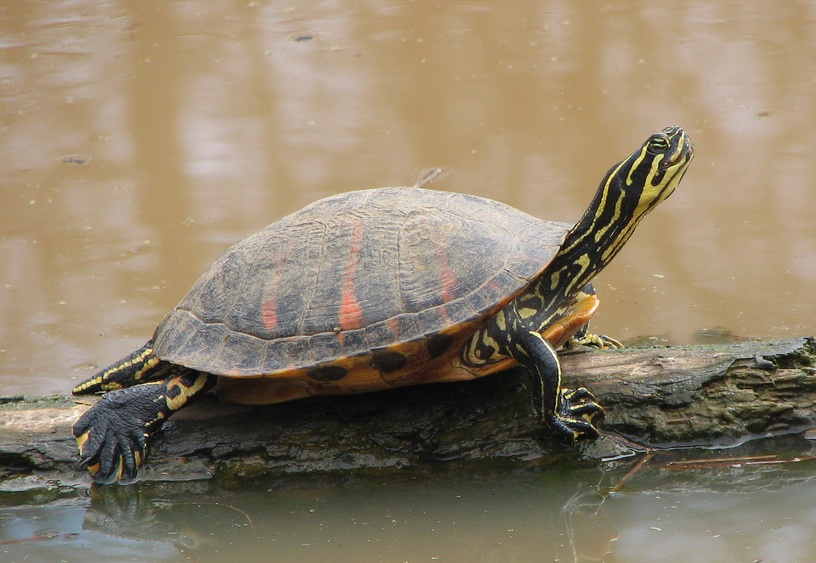
by Rick O'Connor | Jun 18, 2020
Cooters are common freshwater turtles throughout the state of Florida. There are currently three species listed: Pseudemys concinna – commonly known as the “river cooter”, Pseudemys floridana – referred to as the “Florida cooter”, and Pseudemys nelsoni – the “Florida red-bellied turtle”. It is this third species we will focus on in this article.
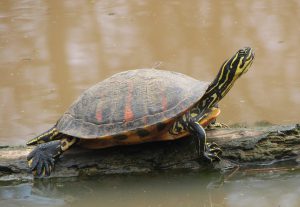
The wide red markings contrasting with the yellow striping on the body makes this a beautiful turtle.
Photo: Wikipedia
When you pick up a Florida red-bellied turtle you will see why it gets that name. The belly, or plastron, is a reddish-orange color. You will also see red coloration of the large broad stripes on the carapace and small red spots on the marginal scutes of the carapace. Contrasting this with the brilliant yellow stripes of the head and legs – this a beautiful turtle.
Like other cooters, they are big pond turtles as well – reaching carapace lengths up to 15 inches. They have high domed shells, compared to the other two cooters, and the shell is much thicker. This is probably due to the fact that the Florida red-bellied lives with the American alligator. They are known to even lay their eggs in an alligator nest! Other features that separate them from their cousins is the presence of yellow striping between the eyes resembling an “arrow”, and a deep notch in the upper lip.
The distribution of this turtle is interesting. They are definitely found, and are common, in the peninsular part of the state – ranging from the Okefenokee Swamp in southern Georgia to the Florida Everglades. Here they most frequently found in slow moving backwaters of rivers and springs, lakes, ponds, marshes, sinkholes, and even canals along highways. However, there have been verified reports of this animal in the Apalachicola River basin. Several have been found on St. Vincent island between Apalachicola and Port St. Joe. One was photographed within the city limits of Apalachicola and a few in the Dead Lake region of the Chipola River feeding into the Apalachicola. There is about 100 miles between the Suwannee and Apalachicola River systems – how did they make this trip?

The red coloration of the common Florida Red-bellied turtle.
Photo: Flickr
One idea is that someone brought them there a long time ago – and they have survived. A long time meaning prior to the 1950s. Another thought is that the historic range may have included much of the Florida panhandle before sea level changed. There is an Alabama Red-bellied turtle (Pseudemys alabamensis) that inhabits the marshes of the Mobile Bay delta. The habitat here is very similar to the marshes of the Everglades, and the Apalachicola region. The Alabama red-bellied has very similar characteristics to the Florida red-bellied (arrow stripes and notch in upper lip). There are no records of the Alabama Red-bellied in the delta of the Escambia River, and no record of either species in the Choctawhatchee delta. So, who knows??? To add to the story – one Florida Red-bellied was verified in the Wacissa River – which lies about halfway between the Suwannee and the Apalachicola rivers. Yep… interesting mystery.
Like other cooters, the females are larger than the males and the males have elongated fingernails on their forelimbs to entice the female’s interest in mating. These long fingernails are also found on the sliders (Trachemys). In Florida, the red-bellied appears to breed year-round. Even though nesting is typical of other turtles (spring and summer) they may lay eggs year-round as well.
The females will approach the beach multiple times during the nesting season and lay anywhere from 6-30 eggs in the nest. Sex determination of the young is determined by the temperature within the nest, warmer eggs become females. The Florida red-bellied has an unusual habit of laying some of their eggs in alligator nests. Though alligators can be considered a predator of this turtle, sneaking in and laying eggs will provide protection – for unlike turtles, alligators guard their nests from predators. It is believed the thicker shell of the Florida red-bellied is to protect it from this possible adversary.
That said, they do have their predators. Like all young turtles there are a variety of birds, fish, mammals, and reptiles that feed on them. Red-bellies are plant eaters – feeding on a variety of aquatic plants including the invasive water hyacinth and hydrilla.
These are common basking turtles throughout much of peninsular Florida and visitors should easily get a glimpse of them while they are here. How far into the Florida panhandle they range is still a mystery – but an interesting one. I hope one day you get to see this beautiful turtle.
References
Buhlmann, K., T. Tuberville, W. Gibbons. 2008. Turtles of the Southeast. University of Georgia press, Athens GA. 251 pp.
Meylan, P.A. (Ed.) 2006. Biology and Conservation of Florida Turtles. Chelonian Research Monographs No.3. 376pp.
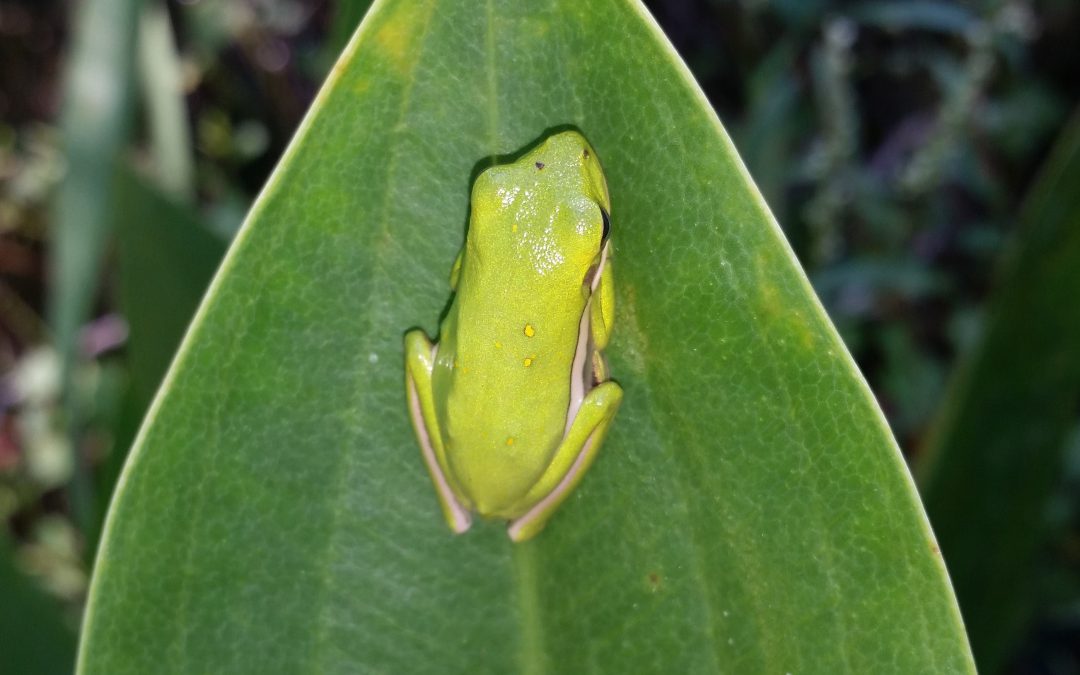
by Erik Lovestrand | Jun 4, 2020
WOW… is all I can say, when I step outside at night of late and become immersed in the spectacular chorus of calls from breeding frogs and toads near my Wakulla County residence. The sound reverberates to the level where it sometimes feels like it is echoing inside one’s head. Recent heavy rains have awakened local species to the notion that there is no time like the present for pro-creation; given the fact that many of the shallow, depressional wetlands in our region will only contain water for a short window of time.
This may seem like a drawback to the life style of frogs and toads that depend on these wetlands but nature has a way of surprising us with incredible adaptations for survival. For instance, the eastern spadefoot toad (Scaphiopus holbrookii) can actually survive through several years with no water available for raising their young. They do this by remaining buried in the ground, only emerging after heavy rains that collect in depressions. Tadpoles metamorphose into small toads within 28 days so by the time the pool goes dry they are likely long-gone. Female spadefoots will lay over 2,000 eggs at a time so the number of progeny that can emerge from a small depressional wetland is phenomenal. I recall seeing black stains across roadways all over the County about a month after one of our tropical storms. Baby spadefoot toads were dispersing by the millions from hundreds of shallow pools across the region and local roadways were one of the hazards they faced on their journey.
Another advantage to amphibians breeding in ephemeral (temporary) wetlands has to do with the fact that there are no fish to prey on the tadpoles. This is not a requirement for all species, as some have chemical defenses (bad taste) that limit predation, but others could not successfully breed in permanent bodies of water.
Some of the species I have heard calling lately include squirrel treefrogs, green treefrogs, Cope’s gray treefrogs, southern toads, cricket frogs, and a few others I have not identified yet. If you have never made an effort to identify the night calls of frogs and toads, you don’t know what you are missing in your local environment. Some are quite difficult to separate but many of very distinct and once you put the call with a name you won’t ever forget it. Take a moment to listen to one of my favorites, the southern toad; the origin of a beautiful, high-pitched trill that you most likely have never paid much attention to. This website (The Frog Blog) is a great resource to learn more calls. Be sure to listen also to the southern cricket frog call that sounds like two marbles clacked together, and Copes’ gray treefrog, which many might mistake for a bird as they call from high in the tree canopy.
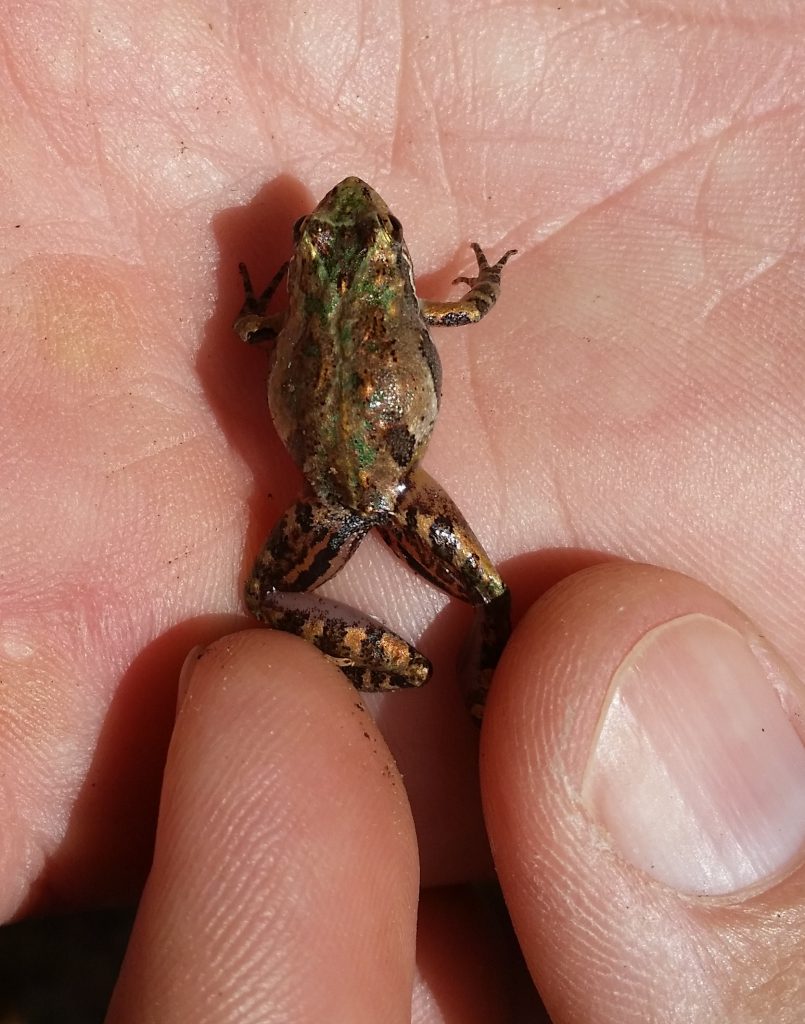
Cricket frogs are one of the smallest vertebrates on the planet.
The cacophony of sounds on a warm summer’s night can seem chaotic and random but if you spend a little time sorting out the musicians, you are sure to develop a deeper appreciation of the symphony, along with a better understanding of the well-orchestrated cycles of nature in your Panhandle backyard.
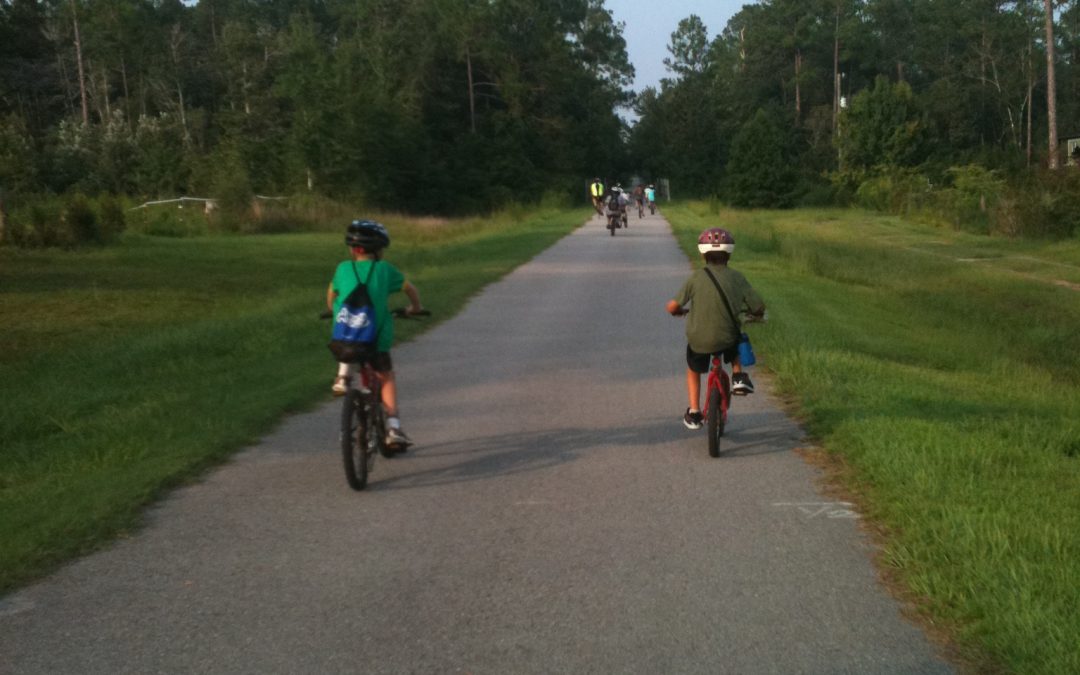
by Carrie Stevenson | May 29, 2020
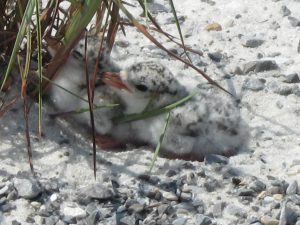
Baby terns on Pensacola Beach are camouflaged in plain sight on the sand. This coloration protects them from predators but can also make them vulnerable to people walking through nesting areas. Photo credit: UF IFAS Extension
The controversial incident recently in New York between a birdwatcher and a dog owner got me thinking about outdoor ethics. Most of us are familiar with the “leave no trace” principles of “taking only photographs and leaving only footprints.” This concept is vital to keeping our natural places beautiful, clean, and safe. However, there are several other matters of ethics and courtesy one should consider when spending time outdoors.
- On our Gulf beaches in the summer, sea turtles and shorebirds are nesting. The presence of this type of wildlife is an integral part of why people want to visit our shores—to see animals they can’t see at home, and to know there’s a place in the world where this natural beauty exists. Bird and turtle eggs are fragile, and the newly hatched young are extremely vulnerable. Signage is up all over, so please observe speed limits, avoid marked nesting areas, and don’t feed or chase birds. Flying away from a perceived predator expends unnecessary energy that birds need to care for young, find food, and avoid other threats.
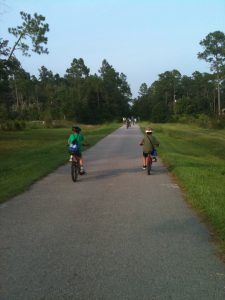
When on a multi-use trail, it is important to use common courtesy to prevent accidents. Photo credit: Carrie Stevenson, UF IFAS Extension
- On a trail, the rules of thumb are these: hikers yield to equestrians, cyclists yield to all other users, and anyone on a trail should announce themselves when passing another person from behind.
- Obey leash laws, and keep your leash short when approaching someone else to prevent unwanted encounters between pets, wildlife, or other people. Keep in mind that some dogs frighten easily and respond aggressively regardless of how well-trained your dog is. In addition, young children or adults with physical limitations can be knocked down by an overly friendly pet.
- Keep plenty of space between your group and others when visiting parks and beaches. This not only abides by current health recommendations, but also allows for privacy, quiet, and avoidance of physically disturbing others with a stray ball or Frisbee.
Summer is beautiful in northwest Florida, and we welcome visitors from all over the world. Common courtesy will help make everyone’s experience enjoyable.
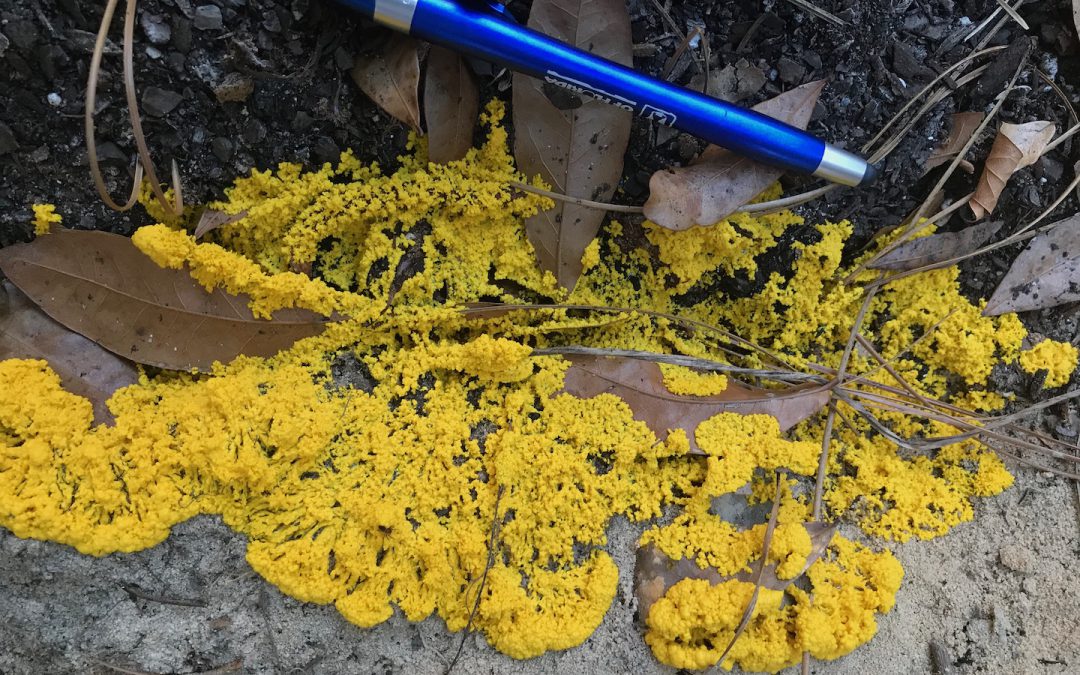
by Laura Tiu | May 22, 2020
Have you ever been on a walk, passed a beautiful flowering bush, and wondered what it was? Well, wonder no more! You can become an expert naturalist by using an easy smartphone app, iNaturalist. With one easy download, you can connect with others to identify species and document their occurrence.
iNaturalist is a community of naturalists, citizen scientists and biologists working together to share observations of biodiversity and map the occurrence. Parents need to know that iNaturalist is an online community that allows users age 13 and older to share pictures and locations of the living things they see around them. While considered very safe, like any online network, teens should be cautious with sharing.
Getting started is easy. All you need to do is create an account at iNaturalist.org and download their free iNaturalist app to your smartphone (Android or iOS). You can then start making your own nature observations, upload them to iNaturalist where you can share your discoveries with others, and also let other iNaturalist users help identify what you have seen.
iNaturalist is a great way to connect with nature and generate scientifically valuable biodiversity data. You can use it for your own personal fulfillment, or as part of a group. You can even use the project feature which allows you to have a central page that displays all the observations made within a location, or all observations made by a group. Why not organize your neighbors, club, or friends and challenge them to post their observations?
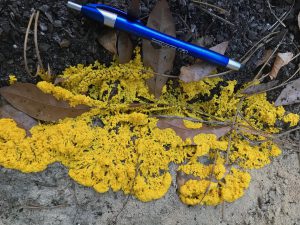
Mystery blob in the garden. Can you figure out what it is? Photo: Laura Tiu
I recently used iNaturalist to identify a bright yellow blob that sprung up in my garden overnight. I won’t spoil the surprise by telling you what it is. Why don’t you head on over to iNaturalist.org and see if you can figure it out? It will be your first step to becoming an expert naturalist.

by Carrie Stevenson | May 8, 2020
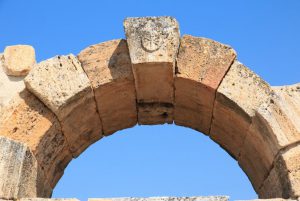
In ecology, a “keystone” species is as crucial to an ecosystem as the central stone in this arch.
In architecture, a “keystone” is the top, central block in an arch structure, the one that holds the entire building up. Without it, the bricks around it collapse. With it, there is nothing stronger.
So, when you hear an animal referred to as a “keystone” species, it should get your attention—especially when that species is listed as threatened by state and federal wildlife agencies. In northwest Florida, one of the species upon which the entire longleaf ecosystem is built is the humble gopher tortoise (Gopherus polyphemus).
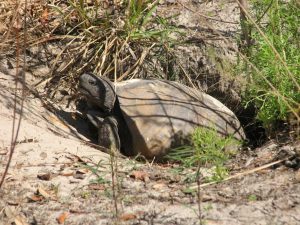
Gopher tortoises are long-lived, protected by their thick shells and deep burrows. Photo credit: Carrie Stevenson, UF IFAS Extension
Once hunted for food and currently in competition with humans for buildable land, this long-lived reptile is an architect in its own right. The tortoises are called “gophers” because of their tunnel building and burrow construction expertise. The tortoises spend about 80% of their time near their burrows, of which they have multiple over their lifetimes. Being a cold-blooded reptile, the burrows allow the tortoises a place to live in the temperature-regulated soil.
The average adult gopher tortoise is about 9-11 inches long, although they can be larger. They have thick feet resembling those of an elephant, and scaly front legs used for digging and burrowing. They are tan, brown, or gray, and live in dry, sandy, upland habitats. Their propensity for dry forestland is typically why their populations are in peril, as this is also the best land for building and development.
The average gopher tortoise’s burrow is 6.5 feet deep and 15-40 feet long, and provides habitat for 350 other species! Those commensal species that share its burrow are mostly invertebrates, but at least 50 are larger backboned species like frogs, snakes, rabbits, and burrowing owls. During forest fires, there are stories of multiple species—from deer and snakes and turtles—calling a truce and hiding in the burrows together until the flames blow over.

Gopher tortoises are nesting right now–be sure to observe from a distance!
Right now—from May to July—is nesting season for gopher tortoises. They lay eggs in the soft sand of their burrow apron, which is the triangular spread of loose sand at the opening of the burrow. Eggs incubate all summer and emerge between August and November. The newly hatched tortoises can expect to live 40 to 60 years in the wild. They live on a variety of grasses and low-growing plants native to longleaf pine, oak forests, and coastal dunes, including wiregrass and gopher apple. They are adapted to routine fires, as they are safe in their burrows and the new growth after a burn provides an abundance of their grassy food sources.
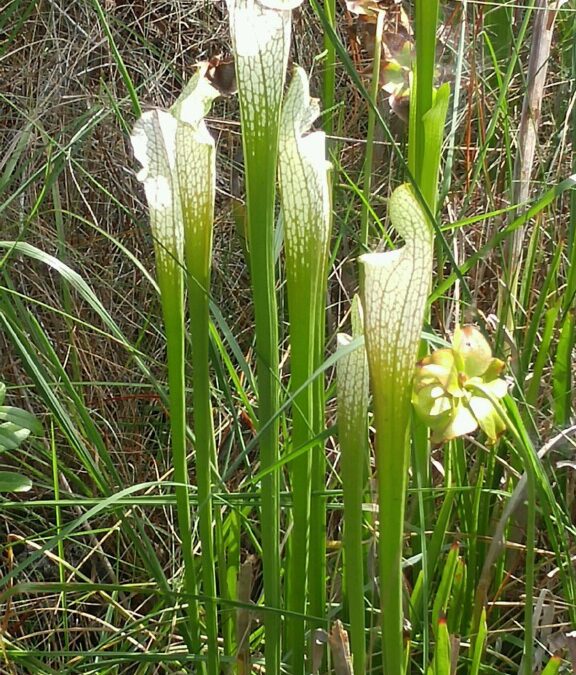
by Carrie Stevenson | Apr 30, 2020
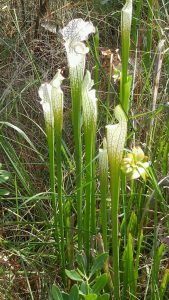
White-topped pitcher plants in bloom at Tarkiln State Preserve. Photo credit: Carrie Stevenson, UF IFAS Extension
If you live in northwest Florida or southeast Alabama and have never laid eyes on our wild native carnivorous plants, it is about time! April and early May are the best time to see them in bloom. We have six species of pitcher plants (Sarracenia), the most common being the white-topped (Sarracenia leucophylla). However, they come in multiple colors, from yellow and red to a deep purple, and in different sizes.
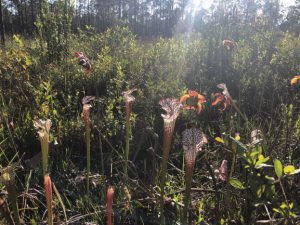
Pitcher plants and their pinwheel-shaped flowers at Splinter Hill Bog. Photo credit: Carrie Stevenson, UF IFAS Extension
One thing they have in common, though—they eat meat. Carnivorous plants all over the world have evolved in places that left them few other options for survival. These plants are typically found in extremely wet, acidic, mucky soils with very low nutrient levels. Normally, plants uptake nutrients like nitrogen and phosphorus from the soil around them. Not being available in these particular environments, carnivorous plants (or more specifically, insectivorous) developed a way to extract nutrients from insects.
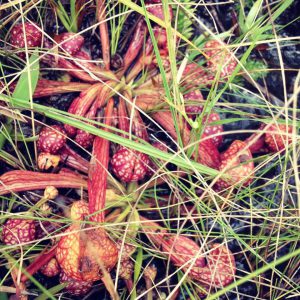
Small parrot pitcher plants lie on the ground instead of standing upright at Blackwater State Forest. Photo credit: Carrie Stevenson, UF IFAS Extension
So how does it work? Pitcher plants have a modified leaf, which instead of lying out flat like most plants, is rolled up into a tube, or “pitcher” shape. The inside of the pitcher has a sweet sap, and the walls of the tube are lined with tiny, downward-pointing hairs. Separate from the leaf, the plant has an elaborate flower structure, which attracts insects for pollination. While nearby, these insects are also attracted to the colorful leaf and the sweet sap in its pitcher. The insect will land on the lip of the leaf, then crawl down.
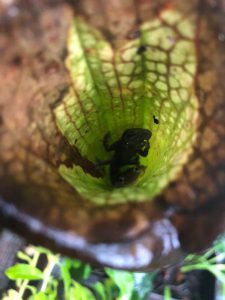 Those sticky, downward facing hairs are a trap, preventing insects from leaving the pitcher. Enzymes—a cocktail of proteins naturally found in many other plants but used creatively here—in the sap break down the bug bodies and convert them to nutrients for the plant. In fact, if you slice a cross-section into a pitcher wall or break open a dried one, you will see countless dried exoskeletons at the bottom of the tube. Several other enterprising species have taken advantage of the pitcher plant’s creative structure. More than once, I have seen tiny spiders spin webs across the mouth of the tube, or small lizards and frogs at the bottom, waiting patiently for prey.
Those sticky, downward facing hairs are a trap, preventing insects from leaving the pitcher. Enzymes—a cocktail of proteins naturally found in many other plants but used creatively here—in the sap break down the bug bodies and convert them to nutrients for the plant. In fact, if you slice a cross-section into a pitcher wall or break open a dried one, you will see countless dried exoskeletons at the bottom of the tube. Several other enterprising species have taken advantage of the pitcher plant’s creative structure. More than once, I have seen tiny spiders spin webs across the mouth of the tube, or small lizards and frogs at the bottom, waiting patiently for prey.
Some of the best places to see pitcher plants in the area—they also bloom in October—are Tarkiln Bayou State Preserve, Weeks Bay National Estuarine Research Reserve, Splinter Hill Bog Preserve, and Blackwater State Forest.


















